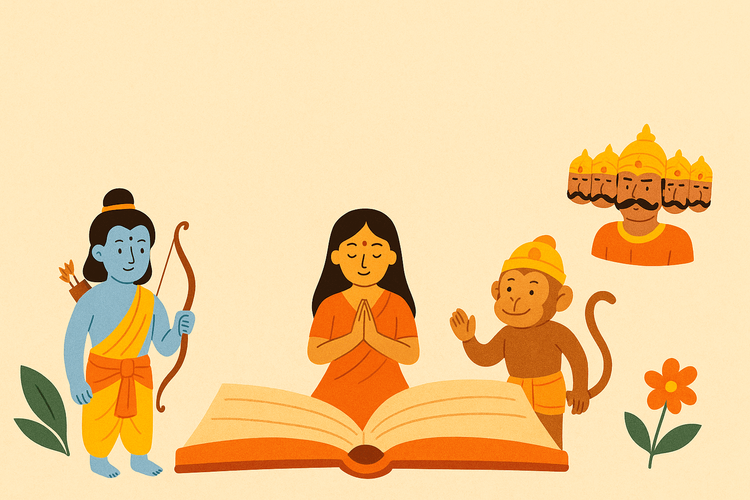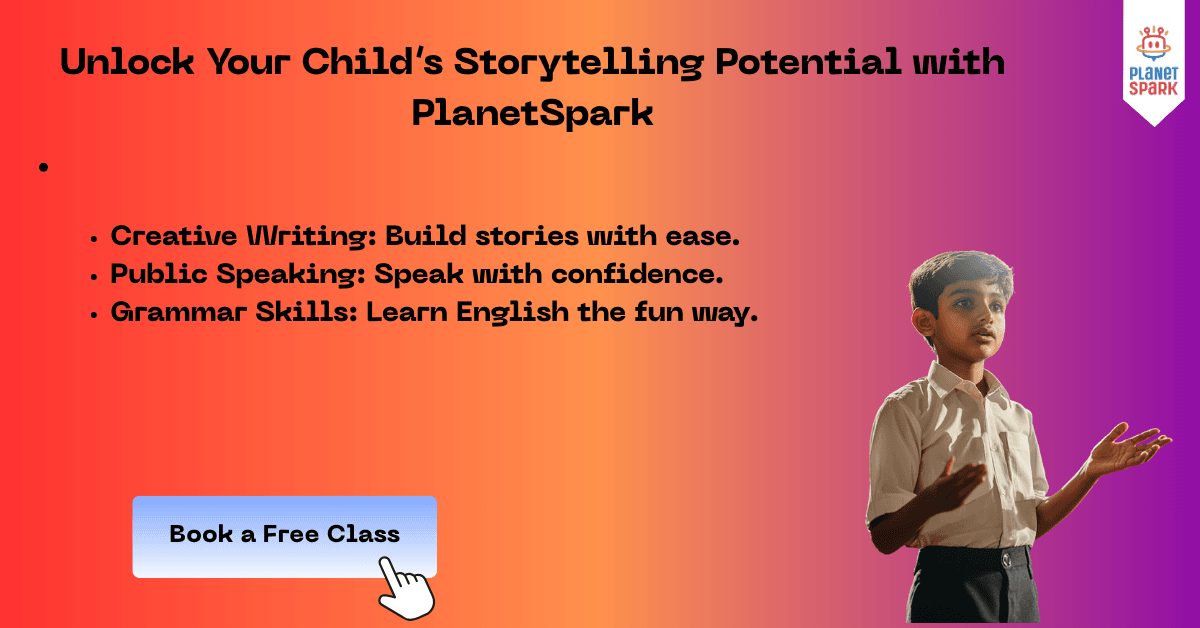Ramayan Story for Kids: Writing Lessons with Sample Essays

The Ramayan is one of the greatest epics ever written. Composed by the sage Valmiki, it tells the story of Lord Rama, Sita, Lakshman, Hanuman, and Ravana. For kids, the Ramayan is more than just an ancient tale. It is full of values, morals, and powerful storytelling techniques that inspire imagination and creativity.
The Ramayan as a Storytelling Masterpiece
The Ramayan is one of the best examples of how stories should be told.
Structure of the Ramayan
Beginning: Birth of Rama, his childhood, marriage to Sita.
Middle: Exile, Sita’s abduction, Rama’s search for her.
End: Battle with Ravana, Sita’s rescue, return to Ayodhya.
Memorable Characters
Rama: Discipline, truth, and responsibility.
Sita: Patience, strength, and loyalty.
Hanuman: Devotion, humility, and courage.
Ravana: Intelligence ruined by arrogance.
Universal Themes
Good vs evil
Sacrifice and devotion
Pride and its consequences
Family and friendship

Why Should Kids Learn the Ramayan?
The Ramayan is not just a religious or cultural story. It is a timeless guide for life and learning. Children who read or listen to it gain:
Moral Lessons: Courage, loyalty, humility, and truth.
Imagination Boost: Palaces, forests, battles, and magic inspire creativity.
Cultural Awareness: Builds connection with India’s traditions.
Language Growth: Improves vocabulary and comprehension.
Writing Practice: Offers ready-made themes for essays and stories.
Book a Free Demo Class today and watch your child fall in love with storytelling.
Storytelling Lessons Kids Can Learn
1. Creating Characters
The Ramayan shows how to write layered characters. Kids can write about Rama’s discipline, Sita’s strength, Hanuman’s loyalty, or Ravana’s pride.
2. Writing Conflicts and Resolutions
From Rama’s exile to the battle in Lanka, the Ramayan is full of conflicts. Children can practice short stories where a problem is introduced and solved.
3. Descriptive Writing
Kids can describe:
Lanka’s golden palaces
The forests where Rama lived
The battle between Rama and Ravana
4. Dialogue Writing
Conversations between Rama, Lakshman, and Hanuman are great examples. Children can role-play these and then write their own dialogues.
Creative Writing Activities for Kids
Write a diary entry as if you were Sita in Lanka.
Imagine Hanuman in the modern world. How would he help?
Write a 10-sentence summary of the Ramayan.
Compare Rama and Ravana in an essay on leadership.
Create an alternative ending to the Ramayan.
Enroll now and help your child master creative writing with the power of stories like the Ramayan.
Essays on the Ramayan for Kids
Essay 1: The Ramayan and Its Lessons
The Ramayan is one of the greatest epics of India and also one of the oldest stories in the world. Written by the sage Valmiki, it has been told, retold, and celebrated for thousands of years. Even today, the Ramayan is not just a story but a guide to life. It teaches us how to live with honesty, courage, and love. For children, the Ramayan is like a mirror that reflects what is right and what is wrong in life.
The story of the Ramayan begins with the birth of Lord Rama, the prince of Ayodhya. Rama was loved by everyone because of his good nature and respect for his elders. He was always obedient to his parents and followed the rules of dharma, or righteousness. His wife, Sita, was also admired for her beauty, patience, and loyalty. Together, they are considered the perfect couple in Indian culture.
The main conflict in the Ramayan happens when Rama is sent to the forest for 14 years as part of a promise his father made. Even though Rama was the rightful king, he obeyed his father without complaint. This teaches us the importance of respecting our parents and elders, even in difficult times. Sita and Lakshman, Rama’s younger brother, also chose to go with him. This shows love, sacrifice, and family unity.
The greatest challenge came when Sita was kidnapped by Ravana, the powerful king of Lanka. Ravana was very intelligent and strong, but he was also arrogant and greedy. His pride became his weakness. To save Sita, Rama built alliances with Hanuman and the monkey army. Hanuman, in particular, showed great courage and devotion. He leapt across the ocean to reach Lanka, gave hope to Sita, and later helped Rama win the war.
The battle between Rama and Ravana is not only about two armies fighting. It represents the fight between good and evil. Rama symbolizes truth, humility, and discipline, while Ravana symbolizes pride, greed, and selfishness. In the end, Rama defeated Ravana and rescued Sita. This ending reminds us that good always wins, no matter how strong evil may seem.
For kids, the lessons from the Ramayan are endless. It teaches us that honesty is always better than lies, patience is stronger than anger, and loyalty is greater than selfishness. The characters are examples of what we should be like and what we should avoid becoming. Rama and Sita inspire us to be disciplined and loyal, while Hanuman teaches us to be brave and humble. On the other hand, Ravana’s downfall shows us how arrogance can destroy even the greatest of men.
The Ramayan also has lessons for writing and storytelling. It shows how a story should have strong characters, conflicts, and resolutions. Kids who read or listen to the Ramayan learn how to describe settings, write dialogues, and bring emotions into their writing. This makes it a great tool for both learning values and practicing creative writing.
In conclusion, the Ramayan is not just an ancient epic but a living story. It inspires children to become better human beings while also helping them learn storytelling skills. Its message is timeless: truth and goodness will always win. That is why the Ramayan remains one of the greatest teachers for kids even today.
Sign up for PlanetSpark’s courses and build your child’s confidence in writing and speaking.
Essay 2: My Favorite Character in the Ramayan
The Ramayan has many great characters, but the one who inspires me the most is Hanuman. Hanuman is not only one of the strongest characters in the epic but also the most humble and devoted. He is often called the greatest devotee of Lord Rama, and his actions throughout the Ramayan make him a perfect example of loyalty, courage, and selflessness.
Hanuman was the son of the wind god, which gave him special powers. He was strong, fast, and fearless. But what makes Hanuman truly admirable is not just his strength but his heart. He never used his powers for selfish reasons. Everything he did was for Lord Rama and the good of others.
One of the most famous moments in the Ramayan is when Hanuman jumped across the ocean to reach Lanka. He did this to find Sita, who was held captive by Ravana. This journey was full of challenges. Hanuman had to face demons, cross dangerous waters, and keep up his courage. Yet, he did not give up. When he finally reached Lanka, he found Sita and gave her Rama’s message of hope. He also gave her Rama’s ring to prove that he was truly Rama’s messenger. This act gave Sita the strength to wait for Rama’s rescue.
Another inspiring moment is when Hanuman carried the Sanjeevani mountain. During the battle against Ravana, Lakshman was badly injured. Rama was heartbroken, and everyone was worried. Hanuman was sent to bring a special herb called Sanjeevani from the Himalayas. When he could not recognize the herb, he lifted the entire mountain and carried it back. This showed not only his strength but also his determination to save Rama’s brother.
What I like most about Hanuman is his humility. Despite all his powers, he never considered himself greater than Rama. In fact, he always said that all his abilities came from Lord Rama’s blessings. This teaches us that no matter how talented or powerful we are, we should always remain humble and thankful.
Hanuman also teaches us courage. In today’s world, children face many challenges like exams, competitions, or learning new skills. Hanuman shows us that with faith, hard work, and devotion, we can overcome any challenge. He did not fear Ravana’s army, the ocean, or even death. His courage was built on his love and devotion for Rama.
For kids, Hanuman is an ideal hero. He is strong but kind, brave but humble, and powerful yet selfless. His devotion to Rama shows us the importance of loyalty and faithfulness. His actions remind us that true greatness lies not in strength alone but in using that strength to help others.
In conclusion, Hanuman is my favorite character in the Ramayan because he represents the values I admire most—courage, humility, loyalty, and kindness. Whenever I feel afraid or doubtful, I remember Hanuman’s devotion and bravery. He inspires me to do my best in everything I try. That is why Hanuman will always remain my favorite character in the Ramayan.
Discover how your child can turn stories into skills—book a demo now.
Essay 3: The Importance of the Ramayan Today
Even though the Ramayan was written thousands of years ago, it continues to be important in today’s world. At first, some people may think that the Ramayan is only a religious book or an old story. But if we read it carefully, we see that it has lessons for everyone, children, parents, teachers, and even leaders.
The Ramayan tells the story of Lord Rama, who faced many challenges in life but always followed the path of truth and righteousness. In today’s world, where people are often in a hurry, stressed, or tempted to take shortcuts, the Ramayan teaches us the importance of patience, honesty, and discipline. Rama’s obedience to his father’s word, even when it meant losing his throne, shows us that keeping promises is more important than personal gain.
For children, the Ramayan is especially valuable. It teaches them how to be respectful to parents, loyal to friends, and courageous in difficult times. Sita’s patience when she was in captivity shows children that strength is not only physical but also mental. Lakshman’s loyalty to his brother shows how important family bonds are. Hanuman’s bravery inspires children to face their fears.
In today’s society, many people struggle with arrogance, selfishness, and greed. Ravana is an example of how intelligence and power can be wasted if not guided by humility. Despite being a great scholar and warrior, Ravana’s pride led to his downfall. This is a lesson for modern times: no matter how successful we are, we should remain humble and respectful.
The Ramayan is also important for building communication and storytelling skills. Children who read or listen to the Ramayan can learn how to describe events, create dialogues, and present conflicts in a story. These skills are very useful for essay writing, public speaking, and creative writing. Even in schools, teachers use stories from the Ramayan to teach children how to think critically and write clearly.
Moreover, the Ramayan encourages cultural awareness. In a global world, where children are exposed to many cultures, knowing the Ramayan helps them understand their own heritage better. It is not just an Indian epic but also a story that has versions in many countries, including Thailand, Cambodia, and Indonesia. This shows its universal value and appeal.
The values of the Ramayan also apply in modern leadership and teamwork. Rama did not fight Ravana alone. He built alliances with Sugriva and Hanuman. This shows that even the best leaders need a team and must respect others’ strengths. Similarly, Hanuman’s actions show us that true leaders are those who serve others with loyalty and humility.
In conclusion, the Ramayan is not just a story from the past, it is a living lesson for the present and the future. It guides us to be better humans, stronger in character, and more creative in our thoughts. For children, it is a perfect balance of fun, adventure, and moral education. That is why the Ramayan continues to be important in today’s world, teaching us lessons that no time can erase.

How PlanetSpark Helps Kids Learn Storytelling
At PlanetSpark, we believe every child has a storyteller inside them, waiting to be discovered. Storytelling is not just about writing or speaking, it is about expressing ideas, building confidence, and connecting with an audience. The Ramayan, with its rich characters and timeless lessons, is a perfect starting point for children to practice these skills.
What PlanetSpark Offers Kids
Creative Writing: Kids learn how to create strong characters, exciting plots, and meaningful resolutions. Just like Rama’s journey or Hanuman’s adventures, children are taught to structure their stories with a beginning, middle, and end.
Public Speaking: Through role-play, debates, and storytelling practice, children gain the courage to speak clearly and confidently. Narrating stories from the Ramayan gives them ready-made material to practice expression, tone, and fluency.
Grammar & Language: Strong writing requires strong grammar. PlanetSpark makes grammar fun through stories, examples, and interactive exercises so children can apply rules directly in their storytelling.
Interactive Learning: Instead of boring lectures, kids engage in quizzes, games, and group discussions. This keeps learning active and enjoyable while reinforcing lessons from epics like the Ramayan.
Personalized Guidance: Every child learns differently. PlanetSpark mentors provide one-on-one support to identify strengths, improve weaknesses, and encourage creativity.
Why Storytelling with PlanetSpark Works
Children gain confidence to share ideas in school, competitions, and daily life.
They learn values like honesty, courage, and humility through stories like the Ramayan.
They improve creativity, imagination, and critical thinking.
They build a strong foundation in English, grammar, vocabulary, and expression.
When kids learn storytelling with PlanetSpark, they do not just become better writers or speakers. They grow into confident, thoughtful individuals who can express themselves clearly and creatively.
FAQs on Ramayan and Storytelling
1. Why should kids read the Ramayan?
Because it builds imagination, values, and storytelling skills.
2. How can the Ramayan improve writing?
It shows examples of character building, dialogues, and themes.
3. Is the Ramayan only a religious text?
No, it is also a literary epic filled with human emotions and life lessons.
4. Can the Ramayan be used for essay writing practice?
Yes, kids can write essays on characters, morals, or retellings of the story.
5. What age is right for kids to learn the Ramayan?
Even young kids can enjoy simple retellings, while older children can analyze themes and write essays.
6. How does storytelling from the Ramayan help in public speaking?
Kids gain confidence, fluency, and memory skills by narrating these stories.
7. Can creative writing be taught using the Ramayan?
Absolutely. It provides ready-made characters, themes, and plots for practice.
8. How can parents encourage kids to learn from the Ramayan?
By reading stories together, asking questions, and encouraging kids to write their own versions.
Personalized Communication Report
Record a video to get a AI generated personalized communication report for your child

Hi There, want to try these
tips for your child with
LIVE with our expert coach?
Let's check your child's
English fluency
